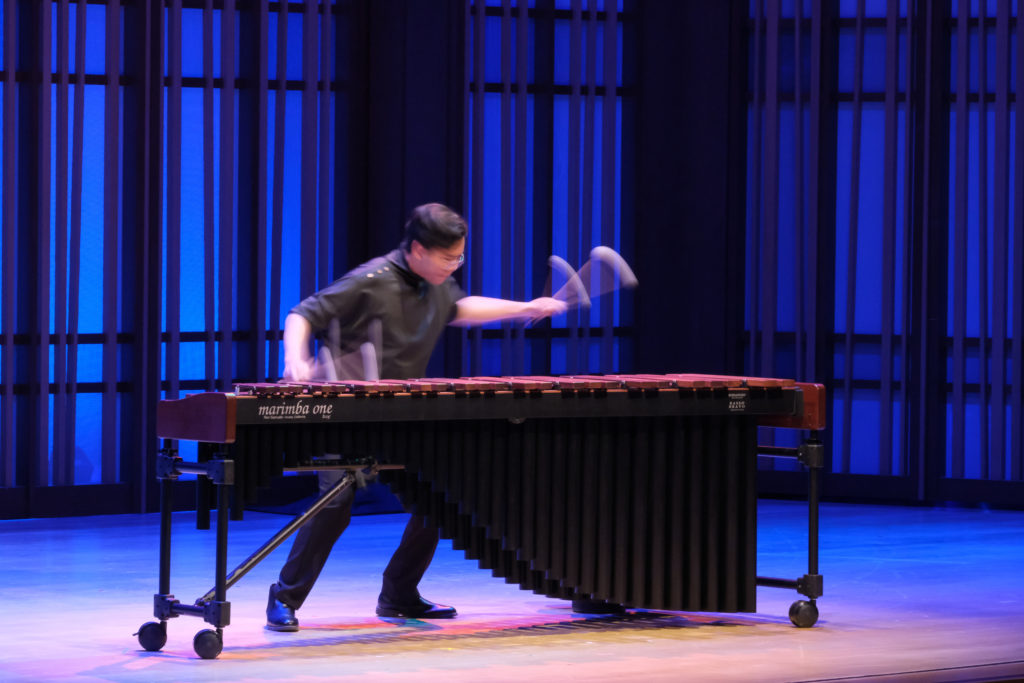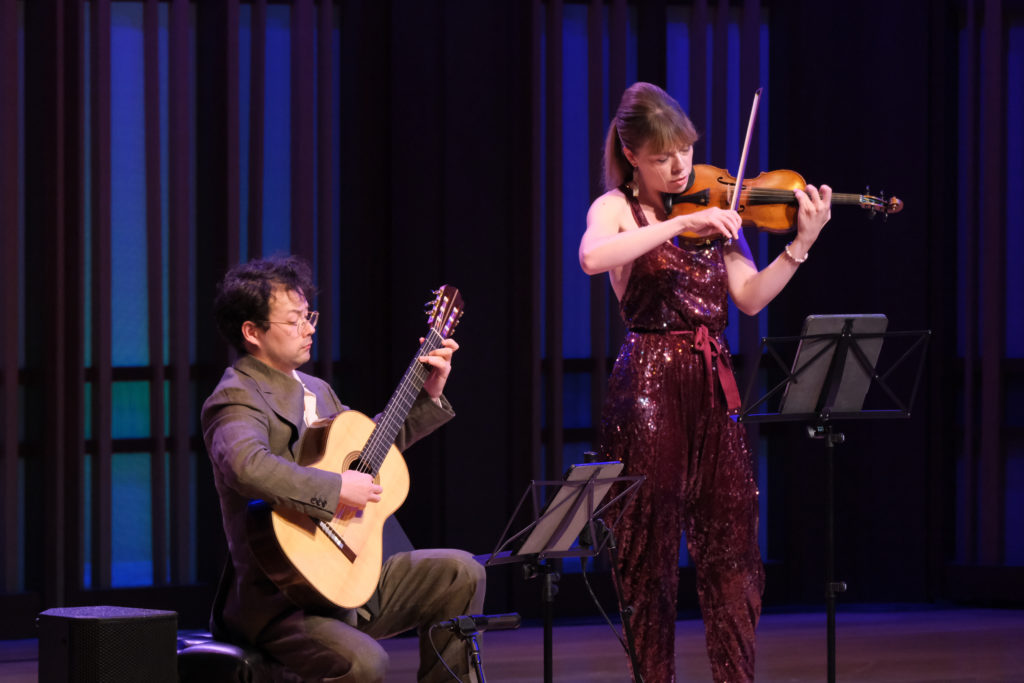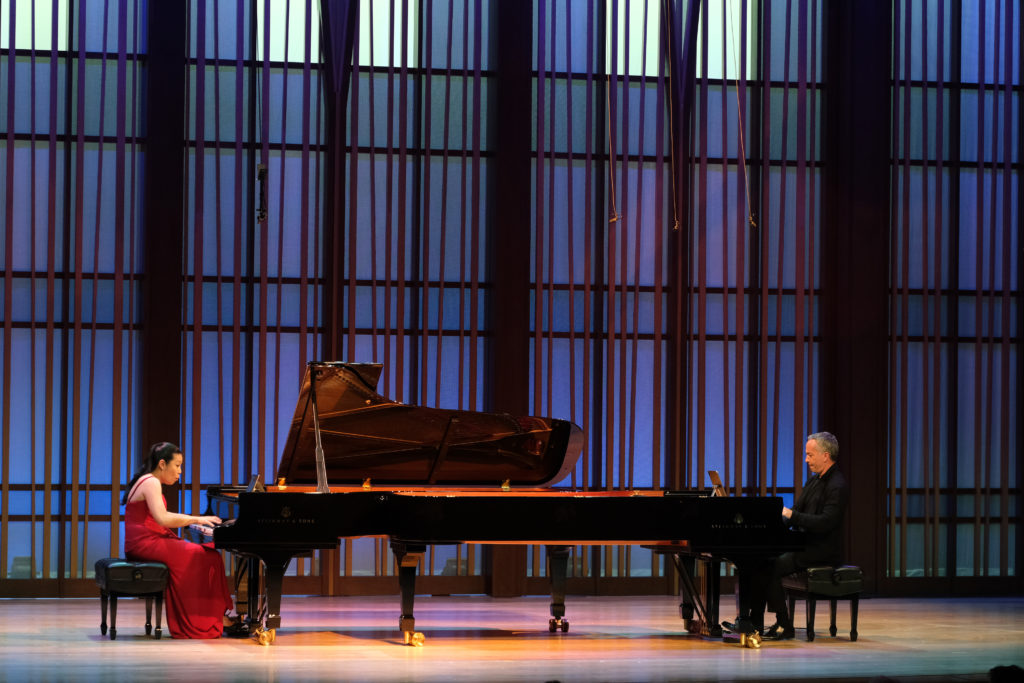SummerFest 2024 Salutes Dance Suites from Bach to Piazzolla
Bravura solos and dazzling duos thrilled Sunday afternoon’s La Jolla SummerFest audience at The Conrad. From Michael Yeung’s balletic account of J. S. Bach Suite in E Minor, BWV 996, transformed on marimba to Music Director Inon Barnatan’s and Joyce Yang’s spectacular account of a two piano arrangement of Tchaikovsky’s beloved Nutcracker Suite, luminous virtuosity ruled supreme. Between these two works, we heard Astor Piazzolla’s sophisticated Histoire du Tango, Stravinsky’s effervescent Neoclassical Suite Italienne, and Paul Lanky’s short modernist essay Three Moves for Marimba.
Because no lute-harpsichord, the strange 18th-century instrument for which Bach wrote this E Minor Suite, has survived, we can only hear this work in transcription. I don’t think I would have suggested the marimba as a likely candidate for the task, but Yeung’s brilliant arrangement of the score and his mesmerizing performance on the marimba made an irrefutable case for choosing this modern percussion instrument.
Of course the tones from a malleted instrument display a marvelous, clean attack, but in this Bach Suite Yeung was also able to create beautifully shaped, sinuous themes that rippled with stylish ornamentation. While his stately “Sarabande” shimmered with transcendent grace, his quick dances pulsed with infectious energy, especially the finale “Gigue,” which provided a rapturous finale for this rarely performed Bach work.
As Argentina’s champion of the nuevo tango, Astor Piazzolla clearly has both the authority to compose a piece that charts the development of tango music from the bordello to the concert hall, as well as the facility to make it a charming composition. Violinist Tessa Lark and guitarist Sean Shibe took us on Histoire du Tango’s clever journey.
Lark’s exuberant take on the vibrant, sexy motifs of the themes in the first movement, “Bordell 1900,” aided by Shibe’s percussive taps on his guitar confidently launched the piece. Shibe’s deft chords calmly set the more sophisticated 1930’s café atmosphere that allowed Lark to imitate the song of a popular crooner. Jazz rhythms and harmonies infiltrate the “Night Club” scene, and as Tango enters the post-modern realm of 1980s classical music, we hear more complex textures and a few extended techniques from Lark.
Stravinsky mined several chamber works from his 1920 ballet Pulcinella, including his Suite Italienne for violin and piano. This is one of Stravinsky’s more entertaining compositions, and pianist Joyce Yang communicated with great finesse and polish the composer’s invention and humor. Her lightening tempo of the “Tarantella” was nothing less than breathtaking, and I appreciated violinist Erin Keefe’s suave melodic turns in the “Serenata” and the “Gavotte.”
When Joyce Yang and Inon Barnatan sat down at the matching concert grands to play Nicolaus Economou’s sumptuous two-piano arrangement of eight movements from Tchaikovsky’s ballet The Nutcracker, I immediately thought of all the coverage we have been seeing of the Paris Olympics. At the Conrad, it seemed as if we were about to experience two musical gold medalists “compete,” and we knew we would not be disappointed.
In truth, it proved to be a magnificent collaboration as these pianists created the orchestral grandeur and radiance of Tchaikovsky’s magical score on two pianos. Beautifully matched in their supple keyboard touch and their preference for pellucid textures, they imbued a Mozartean clarity to the “Overture” and “March,” yet their technical prowess supported a delirious tempo for the Russian “Trepak.” Barnatan made the exotic “Arabian Dance” enchanting, and Yang coaxed luminous celesta-like textures in the piano’s upper range in the “Chinese Dance.” The ingratiating sweep of the final “Waltz of the Flowers” evoked a well-deserved standing ovation.
In a prelude before the program began, Barnatan played a piano arrangement of the J. S. Bach aria “Sheep may safely graze” from the Hunting Cantata, BWV 208, as a tribute to the life of John Anthony Belanich, an outstanding community leader and supporter of the La Jolla Music Society.
This concert was presented by the La Jolla Music Society on August 4, 2024, as part of SummerFest 2024 in La Jolla’s Conrad Prebys Performing Arts Center.

Ken Herman, a classically trained pianist and organist, has covered music for the San Diego Union, the Los Angeles Times’ San Diego Edition, and for sandiego.com. He has won numerous awards, including first place for Live Performance and Opera Reviews in the 2017, the 2018, and the 2019 Excellence in Journalism Awards competition held by the San Diego Press Club. A Chicago native, he came to San Diego to pursue a graduate degree and stayed.Read more…




Wonderful, colorful arrangements, exciting new material and reimaginings – BRAVO!